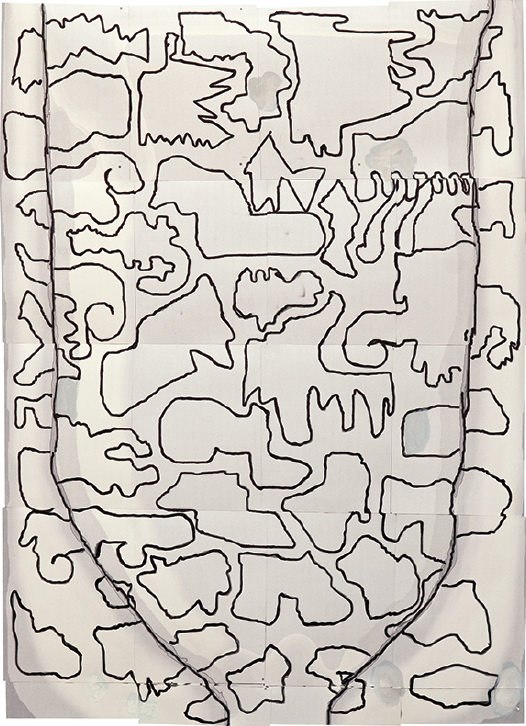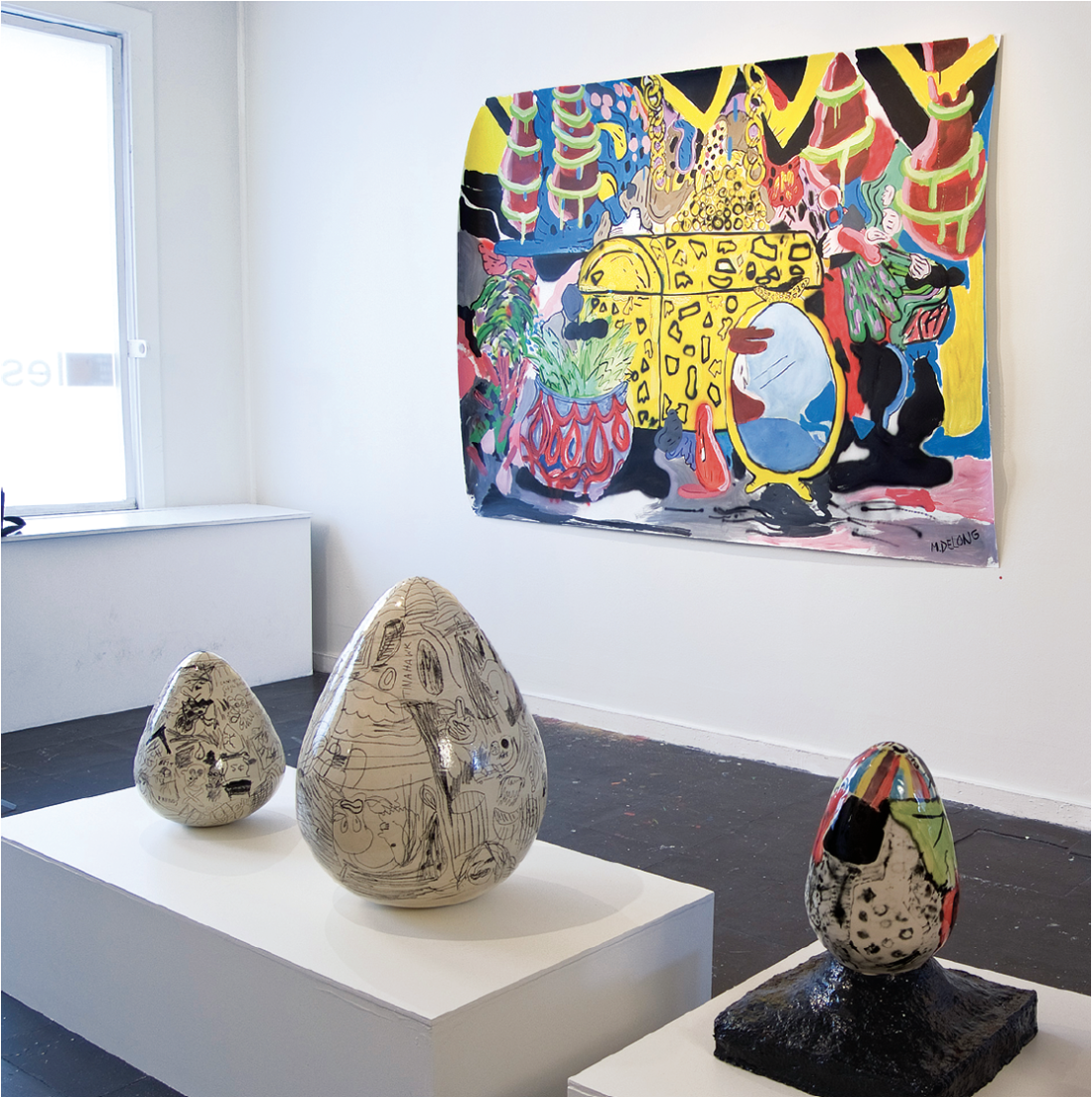Mark DeLong

Mark DeLong, Grey Folding Vase, 2008, acrylic ink and inkjet on paper, 27 x 35”. Courtesy the artist and LES Gallery, Vancouver.
Mark DeLong’s solo show at LES gallery in Vancouver, titled “I Need A Miracle,” features four ceramic eggs nesting low to the ground on plinths surrounded by a half dozen large, medium and small framed acrylics on paper. Since he moved to Vancouver from Nova Scotia about eight years ago, he’s shown striking and uncompromising collages, paintings, sculpture and drawings in many Vancouver galleries and alternative spaces. I curated a group show in 2006 that featured his work. Out East, Toronto galleries have shown him, solo as well as in group shows. He was in Tim Barber’s 2007 “tinyvices” touring group show and the “Pulp Fiction” exhibition that began in London, Ontario, in September, 2008, and is travelling to other cities under a new name. He has released a substantial stack of books with art publishers, and for a few years he had a side-splitting single-panel underground comic in the monthly print edition of Only magazine. DeLong definitely has a tweaked sense of humour. His work doesn’t hinge on a gag quite so frequently as David Shrigley’s, but like Shrigley, a piece will often revolve around an unexpectedly funny metaphysical concept delivered with a quick, quirky doodle. Humour is key to the genius of DeLong. One-offs like A GLASS OF THE RIVER STINKS, images of primary-coloured dogs wearing gold dookie chains, a sample of the Quaalude patois of Top 40 radio, and other Pop motifs reappear time and again in his artwork. And he finds himself in the avant-garde of visual art by way of the Man-hating attitude that dominates skateboard culture. DeLong makes esoteric, anti-social plays on words that the anti-establishment DIY champion Duchamp would surely approve of—Horse Water Chips, Michael Jackson Gallery, Comfortable Coffins, Mrs. Doubtfire, what a drag, Poverty Channel, Tina Hawk. He has an excellent ear for the proverbial, his sense of the tragicomic in our complicated, pitiable common ground of media saturation. The title of his show at LES carries more than a tinge of this collective pity; a recession-weary sentiment perhaps comes first to mind. The title is written on the surface of one of the large ceramic eggs, an egg having a welcome association to miracles. Decorating eggs is a rite of passage for many children learning to colour and cherish the calcium shell that forms to protect the mysterious circumstance of life emerging. DeLong’s eggs are larger than Easter’s—his are closer to womb-sized. Two eggs are as white as paper and covered in doodles. Titled Good Night Hazel, Good Night Fritz, after his two toddlers, the sketches might be their father’s interpretation of their dreams. All four eggs are tributes to birth and childhood, of coming into being. Ceramics are precious, we showcase, we Swiffer, and when we move, we bubble wrap and write “fragile” on the box. Doodles generally get junked. By neglecting their value they become fragile too. We haven’t given the doodle its proper due, not until lately. The best-known doodler perhaps is Scotland’s David Shrigley; there’s also Chris Johanson, Paul McDevitt and others, and like DeLong they use doodling as an illusion of the spontaneous, in-process drawing that is mastered by daily practice. The unpretentious simplicity of the doodle is deceiving. As Philip Guston and George Condo remind, the doodle can be provocative and can challenge the status quo. DeLong continues this satiric tradition on “Fritz’s” egg when he roughs out a dink-nosed caricature of a nude lady with barbed nipples, along with the words “Nelson Mandela Bar” and “506-654-7233 Fruit Leather”: the kind of drawing you do distractedly while talking on the phone, preserved. The other pair of eggs are brightened by the same fireworks as the paintings on LES’s wall.

Mark DeLong, “I Need A Miracle” installation view at LES Gallery, Vancouver, 2009. Courtesy the artist and LES Gallery, Vancouver.
DeLong’s light, bright approach has me thinking especially of Matisse, whose style is similar and was considered by some as primitive as a doodle. DeLong’s colours are equally intense, providing a tableau of chromatics profound enough to taste. His two small paintings of nudes remind me of ones Matisse made in 1909. A hundred years later, DeLong’s rosy pink woman rides a yellow donkey, and in the other she reclines louchely in puddles—the two sirens appear in another painting as apparitions on the shoulders of an untitled portrait of a foppish captain. Graphic combinations of loud and fauvist colours, combined with hard-edged cartoon flatness—it’s a raw style; and to complicate things, most of his paintings are also collages. He’s known for intricate mosaic-tiled work based on layers of digital image-clusters scanned back into the computer with his own acrylics and illustrations added, and printed from the computer and again overlaid with more acrylic and pen, until finally sometimes over a dozen pieces of paper form a seamless image. In what’s perhaps the best example of this process in the show, Grey Folding Vase, 16 separate pages create a single compelling image of a super-flat, two-dimensional vase camouflaged by a matching pattern on the wall behind it.
There is another painting in the show that reminds me of a Matisse-like Harmony in Red or Interior in Aubergines, but again by way of Philip Guston. DeLong’s painting is titled Cheese Chest; its setting is uncertain, possibly an attic, with a hefty cheddar-yellow pirate’s chest at centre, shrouded by potted plants, an oval vanity mirror, and what look like turkey drumsticks wrapped in fluorescent shoelaces. Like Matisse, Mark DeLong is able to push colours to their brightest without a fuse breaking. His work is likely to shine long after much of today’s other production has dimmed. ❚
“I Need A Miracle” was exhibited at LES Gallery in Vancouver from March 20 to April 21, 2009.
Lee Henderson is the author of a book of short stories, The Broken Record Technique. His first novel, The Man Game, was published by Penguin Canada in August 2008. He is a Contributing Editor to Border Crossings.

